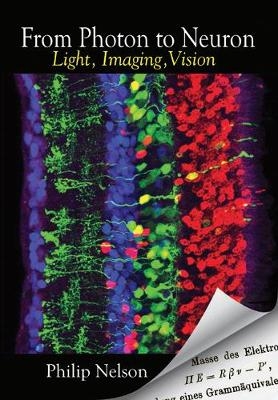
From Photon to Neuron
Light, Imaging, Vision
Seiten
2017
Princeton University Press (Verlag)
978-0-691-17518-8 (ISBN)
Princeton University Press (Verlag)
978-0-691-17518-8 (ISBN)
- Titel ist leider vergriffen;
keine Neuauflage - Artikel merken
A richly illustrated undergraduate textbook on the physics and biology of light Students in the physical and life sciences, and in engineering, need to know about the physics and biology of light. Recently, it has become increasingly clear that an understanding of the quantum nature of light is essential, both for the latest imaging technologies and to advance our knowledge of fundamental life processes, such as photosynthesis and human vision. From Photon to Neuron provides undergraduates with an accessible introduction to the physics of light and offers a unified view of a broad range of optical and biological phenomena. Along the way, this richly illustrated textbook builds the necessary background in neuroscience, photochemistry, and other disciplines, with applications to optogenetics, superresolution microscopy, the single-photon response of individual photoreceptor cells, and more. With its integrated approach, From Photon to Neuron can be used as the basis for interdisciplinary courses in physics, biophysics, sensory neuroscience, biophotonics, bioengineering, or nanotechnology.
The goal is always for students to gain the fluency needed to derive every result for themselves, so the book includes a wealth of exercises, including many that guide students to create computer-based solutions. Supplementary online materials include real experimental data to use with the exercises. * Assumes familiarity with first-year undergraduate physics and the corresponding math * Overlaps the goals of the MCAT, which now includes data-based and statistical reasoning * Advanced chapters and sections also make the book suitable for graduate courses * An Instructor's Guide and illustration package is available to professors
The goal is always for students to gain the fluency needed to derive every result for themselves, so the book includes a wealth of exercises, including many that guide students to create computer-based solutions. Supplementary online materials include real experimental data to use with the exercises. * Assumes familiarity with first-year undergraduate physics and the corresponding math * Overlaps the goals of the MCAT, which now includes data-based and statistical reasoning * Advanced chapters and sections also make the book suitable for graduate courses * An Instructor's Guide and illustration package is available to professors
Philip Nelson is professor of physics at the University of Pennsylvania. He is the author of Biological Physics and Physical Models of Living Systems, and coauthor of A Student's Guide to Python for Physical Modeling (Princeton). Among other honors, he has received the Biophysical Society's Emily M. Gray Award for educational excellence.
| Erscheinungsdatum | 25.05.2017 |
|---|---|
| Zusatzinfo | 300 color illus. |
| Verlagsort | New Jersey |
| Sprache | englisch |
| Maße | 203 x 254 mm |
| Gewicht | 1588 g |
| Themenwelt | Naturwissenschaften ► Chemie ► Analytische Chemie |
| Naturwissenschaften ► Physik / Astronomie ► Angewandte Physik | |
| Naturwissenschaften ► Physik / Astronomie ► Optik | |
| ISBN-10 | 0-691-17518-7 / 0691175187 |
| ISBN-13 | 978-0-691-17518-8 / 9780691175188 |
| Zustand | Neuware |
| Haben Sie eine Frage zum Produkt? |
Mehr entdecken
aus dem Bereich
aus dem Bereich


